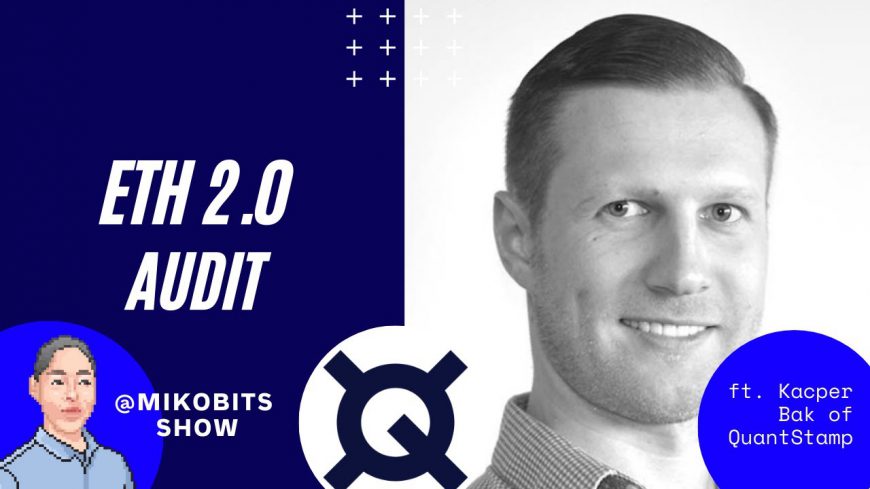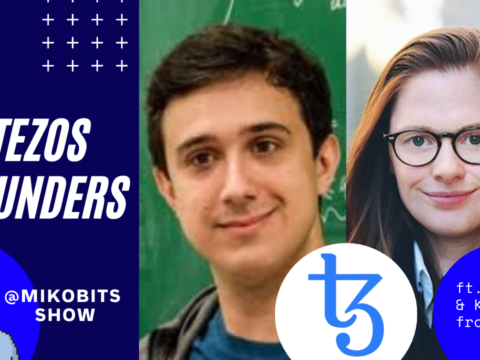
Ethereum 2.0 is a huge step forward for the ETH ecosystem, the largest developer ecosystem in the blockchain.
As of this writing it will launch the “phase zero” mainnet NEXT MONTH, which is July.
This interview is with Kacper Bak who is a senior researcher at Quantstamp and he is responsible for security auditing and testing the “Prism” client for Ethereum 2.0.
This interview is part of the MikoBits show, and it addresses many questions including what is expected in each of the upcoming phases especially including phase zero.
Phase zero includes some of the significant implications including the beginning of the “staking” opportunity, and this staking requires 32 ETH.
In phase one there are basic functions appearing–which is the creation of the Proof-of-Stake layer and not the smart contracts. So this will be coming later, maybe even years later when we see smart contracts in ETH 2.0.
What is expected is the “Beacon Chain” phase, where POS is defined and divides the progress of the network into “Epochs” and picking the voting and block validating elements. All of the subsequent updates depend on this base layer that creates the governance preconditions for full ETH 2.0.
One of the key things about ETH 2.0 is the emergence of “shards” which are essentially clusters. When ETH 2.0 is integrated with ETH 1.0, the 1.0 network will simply just be one of the “shards” of ETH 2.0.
Of course sharing will impact greatly the speed but more importantly the scalability of the network. Essentially each “shard” becomes a universe of its own within the larger ETH 2.0 “multiverse”.
But of course there needs to be communication across these universes. This can create some complexity.
As far as the developer paradigm, sharding can adversely affect modularity of code, and this has not been fully specified yet. The ETH 2.0 doesn’t yet have the Ethereum Virtual Machine or smart contracts so it’s not part of this rollout and in fact havent even yet been fully specified. There could be eWASM instead of EVM, we dont know and this comes not in phase zero or even phase one but that will come in phase two.
How does the “value transfer” aspect work? In order to become a validator node, people will need to lock up 32 ETH into a ETH 1.0 blockchain smart contract. The contract is public and so that validator will be clearly checked and therefore you become allowed to validate on ETH 2.0. There is a bridge between the ETH 2.0 and ETH 1.0. So the private key can be used to sign.
Once you lock your 32 ETH into the staking contract, you cannot go back to ETH 1.0. The intention is that locking the coins into the staking contract, you can never come back to ETH 1.0.
Why go though the trouble? Of course sharding is about scalability (and therefore performance). That means transactions go faster, but of course it also means that you can do MORE transactions and you get more flexibility in terms of how the infrastructure looks at your application.
One of the natural benefits of course is that Proof-of-Work uses tons of electricity, that is one if the big complaints about Bitcoin. But Proof-of-Stake should be relatively much less electricity use (that some people refer to as “wasted electricity”). But the main benefit is speed and scalability.
Remember that the original promise of Ethereum in the original white paper is the idea of building a “World Computer”. So in order to do that there needs to be much much more speed and scale.
One of the big design centers for ETH 2.0 is decentralization. This network is quite focused on ensuring sufficient decentralization to prevent bad actors to create a staking attack by controlling a majority of the stake in the network.
Kacper in reviewing and auditing Prism client, he feels positive about this project and he says this is one of the best specified projects he’s seen, and that this provides considerable confidence in the project overall.
Quantstamp checked to see if the Prism client did exactly what was specified. There also were tests to ensure that there was no split in consensus or that it could handle all kinds of messages, that there would be no foreign code execution, no data integrity problems, no sync problems and best practices like minimizing code clones which impacts maintainability and of course documentation.
This event, says Kacper, is much bigger in scope than the bitcoin halving event. The interesting part of this is that the Ethereum Proof of Work miners will not be needed.
It’s an interesting design because initially the stakers will be staking even though there will be no EVMs running in ETH 2.0 shards.
Disclaimer
Information is provided for general educational purposes only. This presentation is not an offer to sell securities or a solicitation of offers to buy securities. Nothing contained herein constitutes investment or other advice nor is it to be relied on in making an investment decision. For more important information, please see disclaimer



